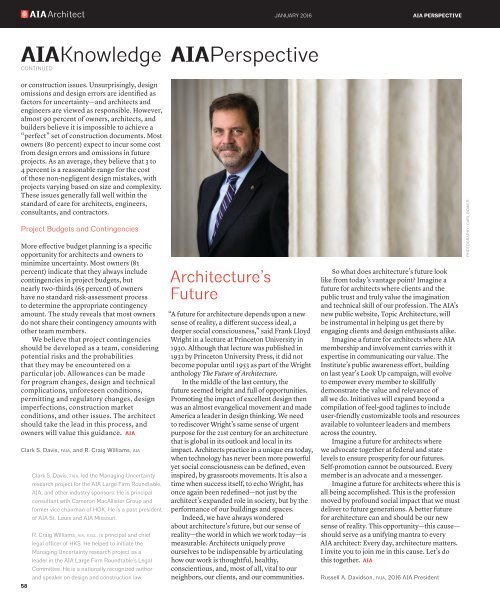Architect 2016-01
You also want an ePaper? Increase the reach of your titles
YUMPU automatically turns print PDFs into web optimized ePapers that Google loves.
AIA <strong>Architect</strong><br />
JANUARY <strong>2<strong>01</strong>6</strong><br />
AIA PERSPECTIVE<br />
AIAKnowledge<br />
CONTINUED<br />
AIAPerspective<br />
or construction issues. Unsurprisingly, design<br />
omissions and design errors are identified as<br />
factors for uncertainty—and architects and<br />
engineers are viewed as responsible. However,<br />
almost 90 percent of owners, architects, and<br />
builders believe it is impossible to achieve a<br />
“perfect” set of construction documents. Most<br />
owners (80 percent) expect to incur some cost<br />
from design errors and omissions in future<br />
projects. As an average, they believe that 3 to<br />
4 percent is a reasonable range for the cost<br />
of these non-negligent design mistakes, with<br />
projects varying based on size and complexity.<br />
These issues generally fall well within the<br />
standard of care for architects, engineers,<br />
consultants, and contractors.<br />
Project Budgets and Contingencies<br />
More effective budget planning is a specific<br />
opportunity for architects and owners to<br />
minimize uncertainty. Most owners (81<br />
percent) indicate that they always include<br />
contingencies in project budgets, but<br />
nearly two-thirds (65 percent) of owners<br />
have no standard risk-assessment process<br />
to determine the appropriate contingency<br />
amount. The study reveals that most owners<br />
do not share their contingency amounts with<br />
other team members.<br />
We believe that project contingencies<br />
should be developed as a team, considering<br />
potential risks and the probabilities<br />
that they may be encountered on a<br />
particular job. Allowances can be made<br />
for program changes, design and technical<br />
complications, unforeseen conditions,<br />
permitting and regulatory changes, design<br />
imperfections, construction market<br />
conditions, and other issues. The architect<br />
should take the lead in this process, and<br />
owners will value this guidance. AIA<br />
Clark S. Davis, FAIA, and R. Craig Williams, AIA<br />
Clark S. Davis, FAIA, led the Managing Uncertainty<br />
research project for the AIA Large Firm Roundtable,<br />
AIA, and other industry sponsors. He is principal<br />
consultant with Cameron MacAllister Group and<br />
former vice chairman of HOK. He is a past president<br />
of AIA St. Louis and AIA Missouri.<br />
R. Craig Williams, AIA, ESQ., is principal and chief<br />
legal officer of HKS. He helped to initiate the<br />
Managing Uncertainty research project as a<br />
leader in the AIA Large Firm Roundtable’s Legal<br />
Committee. He is a nationally recognized author<br />
and speaker on design and construction law.<br />
<strong>Architect</strong>ure’s<br />
Future<br />
“A future for architecture depends upon a new<br />
sense of reality, a different success ideal, a<br />
deeper social consciousness,” said Frank Lloyd<br />
Wright in a lecture at Princeton University in<br />
1930. Although that lecture was published in<br />
1931 by Princeton University Press, it did not<br />
become popular until 1953 as part of the Wright<br />
anthology The Future of <strong>Architect</strong>ure.<br />
In the middle of the last century, the<br />
future seemed bright and full of opportunities.<br />
Promoting the impact of excellent design then<br />
was an almost evangelical movement and made<br />
America a leader in design thinking. We need<br />
to rediscover Wright’s same sense of urgent<br />
purpose for the 21st century for an architecture<br />
that is global in its outlook and local in its<br />
impact. <strong>Architect</strong>s practice in a unique era today,<br />
when technology has never been more powerful<br />
yet social consciousness can be defined, even<br />
inspired, by grassroots movements. It is also a<br />
time when success itself, to echo Wright, has<br />
once again been redefined—not just by the<br />
architect’s expanded role in society, but by the<br />
performance of our buildings and spaces.<br />
Indeed, we have always wondered<br />
about architecture’s future, but our sense of<br />
reality—the world in which we work today—is<br />
measurable. <strong>Architect</strong>s uniquely prove<br />
ourselves to be indispensable by articulating<br />
how our work is thoughtful, healthy,<br />
conscientious, and, most of all, vital to our<br />
neighbors, our clients, and our communities.<br />
So what does architecture’s future look<br />
like from today’s vantage point? Imagine a<br />
future for architects where clients and the<br />
public trust and truly value the imagination<br />
and technical skill of our profession. The AIA’s<br />
new public website, Topic <strong>Architect</strong>ure, will<br />
be instrumental in helping us get there by<br />
engaging clients and design enthusiasts alike.<br />
Imagine a future for architects where AIA<br />
membership and involvement carries with it<br />
expertise in communicating our value. The<br />
Institute’s public awareness effort, building<br />
on last year’s Look Up campaign, will evolve<br />
to empower every member to skillfully<br />
demonstrate the value and relevance of<br />
all we do. Initiatives will expand beyond a<br />
compilation of feel-good taglines to include<br />
user-friendly customizable tools and resources<br />
available to volunteer leaders and members<br />
across the country.<br />
Imagine a future for architects where<br />
we advocate together at federal and state<br />
levels to ensure prosperity for our futures.<br />
Self-promotion cannot be outsourced. Every<br />
member is an advocate and a messenger.<br />
Imagine a future for architects where this is<br />
all being accomplished. This is the profession<br />
moved by profound social impact that we must<br />
deliver to future generations. A better future<br />
for architecture can and should be our new<br />
sense of reality. This opportunity—this cause—<br />
should serve as a unifying mantra to every<br />
AIA architect: Every day, architecture matters.<br />
I invite you to join me in this cause. Let’s do<br />
this together. AIA<br />
Russell A. Davidson, FAIA, <strong>2<strong>01</strong>6</strong> AIA President<br />
PHOTOGRAPHY: CARL BOWER<br />
58

















